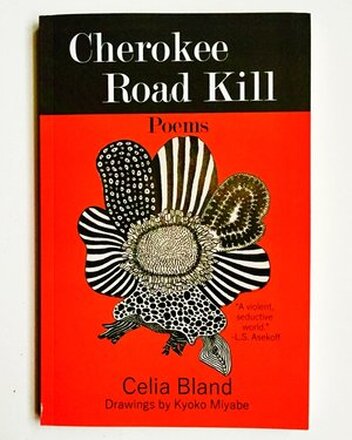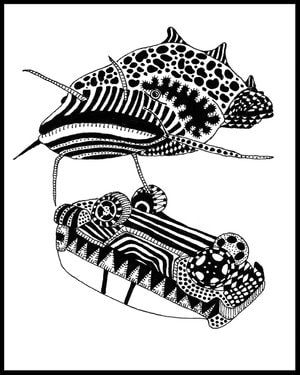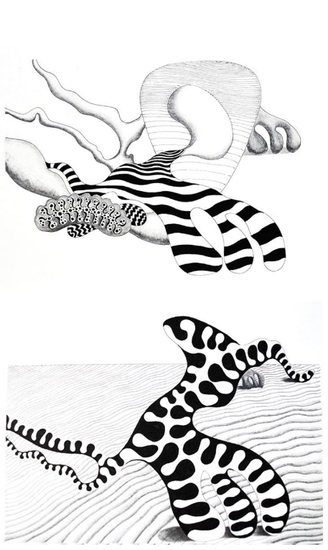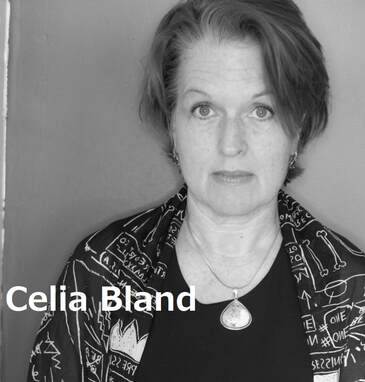|
Some people have never done collaborated works. When I watched reality TV shows like Project Runway, candidates sometimes did not get along in their group projects. So did some writing classes that I took in the past. Do collaborated projects give us a headache? Often, we as artists are so focus on our individual achievements that we cling to what we've already established. I've done it. But through the experience, I think that only individual success means less than we think in the long run. Our individual creativity shines when we have multiple unique creations around us. If our community is boring, our own art might be boring too. Through 2020 and 2021, I witnessed multiple collaborative works between poetry & art. I asked about their creative processes, and one thing that I noticed was that they were light as a feather, in contrast to unsuccessful collaborations feeling heavy and incoherent. Craft Essays by Collaborated Artists in the Working On Gallery: Gail Goepfert x Patrice Boyer Claeys
The successful collaborative works were rigid as a whole presentation, and I could feel trust and respect from the final products. It is so hard to find the best match for a collaborated work. But how exciting it is when you find a great teammate in your creative process! Today's guests, Celia Bland & Kyoko Miyabe, intermingled their creative approaches when they collaborated on Cherokee Road Kill & one broadside together. In the following video, I read "Brave" from Cherokee Road Kill. Bland kindly gifted me a signed copy. Thank you so much. I actually wanted to read "Trail of Tears", but my website did not have the capacity for a long record. It is a 6 page-poem, each page has a paired drawing on the side. I think that the poem truly highlighted both a collaboration of Bland's words and Miyabe's images. If you are interested in seeing the beautiful work, find out! Sight itself is a picture. By Celia Bland My mother is an artist and even now, in her 80s, she paints every day. When she runs out of blank canvases, she begins painting over paintings. For her, the act, the practice, matters more than any objectified goal. Watching my mother as she opens her birthday presents -- the way she feels of the silky ribbon, lifts the deep pink of the birthday card to her face as if she would taste its color, smooths the wrapping to absorb texture and even sound through her finger tips – it’s almost too private to watch such a sensual dialogue with the world. Growing up with someone who creates beautiful things has made me greedy for beauty. My most recent poems, which take the form of scripts for a TV series about Andrew Jackson and the Seminole leader, Osceola, were spawned by memories of my childhood in Florida where my mother was an art professor. Shut-in, cut off, here in the Hudson Valley of New York, since March, I was reading about Mar-a-Lago and the pro-Trump regattas, about the absurd, tragic response of the Florida governor to Covid-19 and the death tallies, and I began thinking about the Seminole Wars that resulted from a very Florida-style land grab in the 1830s. President Andrew Jackson’s (illegal) proclamation that the Seminoles be “removed” from their lands in central Florida to Indian Territory west of the Mississippi, followed the removal of the Cherokee from the Carolinas and Georgia (an event underlying and influencing the poems in my last collection, Cherokee Road Kill). I was also remembering the three-dimensional “feel” of Florida. Black Palmetto roaches as big as your palms. Thunderstorms. The wind whipping moss-bedecked trees and spined palmettos until they tossed and twisted like grieving women. The sand that scalded your feet, and yet was cool and damp immediately beneath the sun-blistered surface. And the people who sat telling stories on themselves – their mistakes and foolishness, the world’s ridiculousness. Failure. That's what I wanted to write about. But not in the first-person. Almost as a listener who laughs wryly, bitterly. “Shooting Script: Brazen Jackson, Season One, Ep. 1-13” was the result. Kyoko, who collaborated with me on Cherokee Road Kill (Dr. Cicero Books), was kind enough to create drawings that could accompany these poems. Her work, like her conversation, is hyper-articulate. What she expresses in these drawings, as it relates to my poetry, is a parallel force: "The force that through the green fuse drives the flower," to quote Dylan Thomas. What she draws (literally?) from the poetry is not the action of the poem but the impetus of the poem. I find a correlative in Robert Rauschenberg’s work with Merce Cunningham. Rauschenberg related less to Cunningham’s choreography than to the revolutionary energy – the curving, tensile, spiraling propulsion -- he brought to dance. The yes’s and no’s as decisions are made each literal minute of music, noise, movement, and language. Rauschenberg’s backdrops, props, and costumes complicate and complement these aesthetic decisions. You see thinking in their work together. I find in Kyoko’s clarity of line the singular hand of an artist who creates life in her drawings. The evidence of decisions – so many! so infinitesimal! – is in every directive of the line. The slight bleed of ink on fine grained paper is heartbreaking. Her work leaps away from Phillip Guston’s organic shapes, infusing them with femininity. Rather than the heavy boots, factory chimneys, and hooded figures of his canvases, we find epidermal layers taking on the curling force of pistils, hairs, and sockets. Here is the dynamism of curving lines, resting and interdependent. Hairy tendrils of stem, sharp-bladed leaves, curves of hip and knuckle, bumper and mushroom cap. I recognize the thrusts and torques of poetic lines. Here is the anarchic “Shooting Script” -- its gallows humor, cultural naming, bitter vitality, critique, and tragedy. All of which will, I hope, prompt readers to ask: when the mediums are so different, the images so different, the languages of the lines so different -- what could possibly connect poem with image, image with poem? What are we seeing? What ideas are incited, provoked, and solicited here? You got me. Between Kyoko’s work and my own I find a frictive conversation. A sly enticement to look and listen. Our collaboration takes the form of a reiterative question that remains stubbornly and tearfully open to all comers. In closing, allow me to mention that our most recent collaboration is a broadside of new images and poetry published by Green Kill Gallery in Kingston, NY. If anyone would be interested in a pdf of the broadside, please write to: 229greenkill {at} greenkill.org. By Kyoko Miyabe When Celia approached me about a project to create drawings for her latest poems, I was excited about being able to collaborate with her again. What soon dawned on me though was that this project entailed a new approach. For Cherokee Road Kill, I selected some of the poems’ detailed elements that stood out to me -- such as a rooster, a green skirt, and “a whiskery catfish god” -- and created drawings of them. The images grew out of my vicarious engagement with the landscape and the inhabitants of the Great Smoky Mountains of North Carolina as recounted by the speakers in Celia’s poems. Perhaps this engagement was similar to how we become involved with places and characters in books, sometimes to the point where they can seem as real as, if not more real than, our immediate world, no matter how distant or unfamiliar they may actually be. Plus, while I did not know Louise -- to whom Cherokee Road Kill, I felt at the time, was ultimately dedicated -- I might have thought that I could maybe be permitted to take part in this elegy as another woman, as another private individual. However, this time with “Shooting Script: Brazen Jackson, Season One, Ep. 1-13,” I recognized the need not only to learn more about the poems’ main figure, Osceola, but also to find a way to approach their larger, more public, historical subject -- one that I felt I did not, and therefore could not be allowed to, share in as someone from a different heritage. The last paragraph in Jonathan Blunk's excellent review of Cherokee Road Kill (The Georgia Review, Summer 2018) offers an insight into this subject, and what is at the core of Celia’s poetry: Bland’s stubborn honesty reminds me of D. H. Lawrence and an essay of his that first appeared nearly a century ago, “The Spirit of Place.” Lawrence argues for the “great reality” of this idea that everywhere on earth has a distinctive and enduring spirit of place. Writing about America and its literature, Lawrence doubts whether we as a people can overcome the legacy of slavery and the genocide of native inhabitants driven from their homelands. This fundamental savagery—and the uncertainty we face as a country—are present throughout Cherokee Road Kill. By honoring a community blighted by this inheritance, Bland has given us a lyrical portrait of a neglected but essential American place. Celia’s latest poems address this "fundamental savagery" underlying the history of the United States in a manner that encapsulates the textures of American culture, both in its enduring and contemporary form. The entry point I was seeking emerged when I read Patricia Riles Wickman’s Osceola’s Legacy (The University of Alabama Press, 2006). In the preface to the revised edition of this book, Wickman writes: To be sure, a main objective of my researches since the initial publication of the book has been to gain a fuller understanding of the cultural, social, and historical context of the man and to locate his missing head. This latter aspect of his story has a high cultural and spiritual value to the Seminole people, and especially the Florida Seminoles, with whom I lived and worked for all the years that the first edition of this book was in publication. It is, consequently, they who have my deepest appreciation for their willingness to share of themselves and of their rich and fascinating universe. It is their belief that the spirit of a deceased person passes out of the physical body through the head in order to make its journey westward, across the Milky Way, to the realm of all the spirits. If the head does not remain connected to the corpus, therefore, the confused spirit may remain too close to the living and can become malevolent, at worst, or a wanderer, at least. (p.xiv) This paragraph immediately made me think of Noh drama, which often retells stories of ghostly spirits unable to completely leave this world because of strong lingering emotions, whether it be sorrow, rage, regret or resentment. I then thought of the image of the old pine tree painted on the back panel of the Noh stage. This image became the starting point for the set of drawings accompanying “Shooting Script: Brazen Jackson, Season One, Ep. 1-13.” These drawings do not directly engage with, but rather, exist in parallel to Celia’s poems. Like the painted old pine tree standing at the back of the Noh stage, they bear witness to the retelling of a tragedy that embodies the “enduring spirit of place.” Celia Bland’s third collection of poetry, Cherokee Road Kill (Dr. Cicero), featured drawings by Kyoko Miyabe. Recent work has appeared in Plume, Witness, Copper Nickel, Southern Humanities Review, and the anthology Native Voices: Indigenous American Poets (Tupelo Press). With Martha Collins she co-edited Jane Cooper: A Radiance of Attention (University of Michigan). Kyoko Miyabe received her Ph.D. in English Literature at Cambridge University, U.K. She is the Chair of the Humanities and Science Department at School of Visual Arts, New York. As a practicing artist, she has exhibited in galleries and art institutions in New York and Philadelphia, including Woodmere Art Museum, Jeffrey Leder Gallery, Stevenson Library at Bard College, New York Hall of Science, and Philomathean Society Gallery at University of Pennsylvania. A selection of her pen-and-ink drawings was published in Celia Bland’s collection of poetry, Cherokee Road Kill (Dr. Cicero Books, 2018). Along with Mariko Aratani, she is the co-translator of By the Shore of Lake Michigan, ed. Nancy Matsumoto (UCLA Asian American Studies Press, forthcoming), a book of tanka poetry by Tomiko and Ryokuyō Matsumoto.
Comments are closed.
|
Archives
July 2024
|
フジハブ
Welcome to FUJI HUB: Waystation to Poetry, Art, & Translation. This is not your final destination. There are many links to other websites here, so please explore them!
Welcome to FUJI HUB: Waystation to Poetry, Art, & Translation. This is not your final destination. There are many links to other websites here, so please explore them!
What are you looking for?
FUJI HUB Directory
Popular Sites:
Gallery of Graphic Poems
Working On Gallery
(Monthly New Article by Writers & Artists)
About Naoko Fujimoto
Contact
Naoko Fujimoto Copyright © 2024
FUJI HUB Directory
Popular Sites:
Gallery of Graphic Poems
Working On Gallery
(Monthly New Article by Writers & Artists)
About Naoko Fujimoto
Contact
Naoko Fujimoto Copyright © 2024








